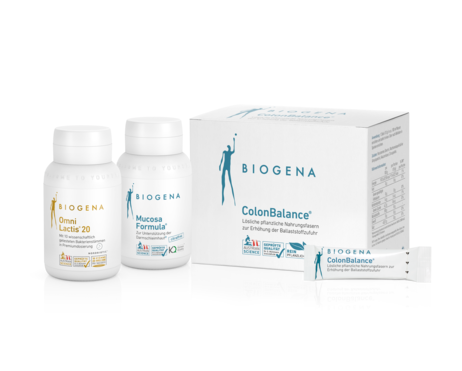Dietary fibre supplements
Dietary fibre is an essential component of a balanced diet and plays a crucial role in our health. It aids digestion, supports intestinal health and contributes to our general well-being. Find out more about the topic here.


Why is dietary fibre important?
Dietary fibre is important for our health for several reasons:
- Aiding digestion: dietary fibre helps keep your digestion regular and healthy by increasing the volume of your stools and stimulating your bowel movements. Provided you consume enough liquid, it can help to prevent constipation and aid normal digestion.
- Healthy gut flora: soluble fibres serve as nutrition for the beneficial bacteria in the gut and are therefore also known as prebiotics. These bacteria play a crucial role in a healthy microbiome, which in turn influences many aspects of our health, including the immune system and nutrient absorption.
- Blood sugar regulation: dietary fibre slows the absorption of sugars into the blood, which helps to stabilise blood sugar levels. This can be particularly beneficial for people with diabetes or for those who want to reduce their risk of developing diabetes.
- Lowering cholesterol levels: soluble fibre can help to lower blood cholesterol levels by reducing the absorption of cholesterol in the intestines. This can reduce the risk of cardiovascular disease.
- Feeling of being full: fibre contributes to a longer feeling of being full by absorbing water and expanding in the stomach. This can help to avoid overeating and support weight control.
- Preventing chronic diseases: a high-fibre diet is associated with a lower risk of various chronic diseases, including heart disease and type 2 diabetes.
Where can I get dietary fibre?
Dietary fibre can be found in a wide variety of foods, including fruit, vegetables, whole grains, nuts and seeds. Fruit such as apples, pears, berries and oranges, and vegetables such as broccoli, carrots, peas and beans are particularly high in fibre. Whole grains such as oatmeal, whole wheat bread and brown rice are also excellent sources. Nuts and seeds, including almonds, chia seeds and flaxseeds, also provide a considerable amount of fibre. A varied diet that includes these foods can help you meet your daily fibre needs.
Tips for a high-fibre diet
- Combining sources: it is ideal to get dietary fibre from a variety of sources to ensure you get a balanced mix of dietary fibre.
- Increase gradually: increase your dietary fibre intake gradually to avoid digestive problems such as bloating or abdominal pain. Drink enough water to help the dietary fibre move through your digestive system effectively.
Taking dietary fibre in supplement form
Dietary fibre is an essential part of a healthy diet, but many people don't get the recommended daily amounts from their food alone. This is where nutritional supplements come in, providing a simple and effective way to increase your fibre intake. Supplements offer a controlled dosage and can be easily added to your daily diet to help support digestion and improve your overall well-being.
Dietary fibre in powder form
Dietary fibres in powder form are a flexible option. These powders can be easily stirred into water, juice or smoothies without significantly affecting the taste. ColonBalance® from BIOGENA contains a very high level of soluble dietary fibres, which serve as nutrition for the intestinal bacteria and offer prebiotic health benefits. Powders such as these are particularly convenient for people who prefer not to swallow tablets or capsules, and allow for flexible dosing according to individual needs.
Dietary fibre as capsules, powders or in stick sachet formats
Dietary fibre capsules, powder and stick sachets are another convenient way to integrate dietary fibre into your daily routine. Capsules are ideal for people who are on the go a lot or who prefer a quick and easy way to take them. These usually contain concentrated forms of dietary fibre and ensure a precise dosage. Dietary fibre in powder form offers the advantage of larger quantities and easy intake by stirring it into meals or drinks. They are also ideal for use at home. For those who prefer to take the equally precisely dosed powder with them on the go, dietary fibre stick sachets are a suitable alternative.
Buy dietary fibre: supplement for a high-fibre diet
When buying dietary fibre supplements, you should make sure that the powder has a highly concentrated level of soluble dietary fibre. The dietary fibre supplements from BIOGENA contain a high proportion of natural ingredients, are well tolerated by the body and ensure optimal absorption. This makes them ideal for supporting your daily dietary fibre intake. However, you should also ensure that your diet is as high in dietary fibre as possible and use the supplements only to support, not replace, a healthy lifestyle.








